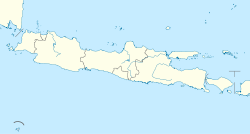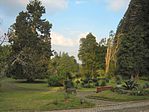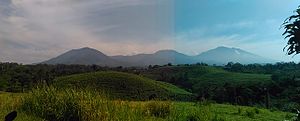world.wikisort.org - Indonesia
Bogor Regency (Indonesian: Kabupaten Bogor) is a landlocked regency (kabupaten) of West Java, Indonesia, south of DKI Jakarta. Covering an area of 2,986.20 km2, it is considered a bedroom community for Jakarta, and was home to 5,427,068 people at the 2020 census.[2] The official estimate as at mid 2021 was 5,489,536.[1] Its administration is located in the town of Cibinong.
Bogor Regency
Kabupaten Bogor ᮊᮘᮥᮕᮒᮨᮔ᮪ ᮘᮧᮌᮧᮁ | |
|---|---|
Regency | |
Clockwise, from top left : Cibodas Botanical Gardens, Puncak, Mount Munara, Mount Salak | |
 Flag  Coat of arms | |
| Motto(s): Prayoga Tohaga Sayaga (Foremost, Robust, Ready) Kuta Udaya Wangsa (City of the dawn of the nation) Tegar Beriman (Steadfast in faith) | |
 Location within West Java | |
 Bogor Regency Location in Java and Indonesia  Bogor Regency Bogor Regency (Indonesia) | |
| Coordinates: 6°28′49″S 106°49′29″E | |
| Country | Indonesia |
| Province | West Java |
| Capital | Cibinong |
| Government | |
| • Acting Regent | Iwan Setiawan |
| Area | |
| • Total | 2,986.20 km2 (1,152.98 sq mi) |
| Population (Mid 2021 Estimate) | |
| • Total | 5,489,536 |
| • Density | 1,800/km2 (4,800/sq mi) |
| [1] | |
| Time zone | UTC+7 (WIB) |
| Area code | 0251 |
| Website | bogorkab.go.id |
The area has witnessed significant population growth. Two areas formerly within the regency have been split off as autonomous cities; on 20 April 1999, the city of Depok was unified with some neighbouring districts of Bogor Regency to form an autonomous city of Depok (independent of the regency); and Bogor city is also an autonomous city (similarly independent of the regency). In spite of these subtractions, Bogor Regency remains the most populous regency in Indonesia.
Origin of name
There are various opinions about the birth of the name Bogor itself. One opinion states that the name Bogor comes from Arabic language, namely Baqar which means cow on the grounds that there is evidence in the form of a statue of a cow in the Bogor Botanical Gardens. Another opinion states that the name Bogor comes from the word Bokor which means palm tree stump. The opinion above has its own basis and reasons for being believed to be true by each expert.
However, based on historical records, on April 7, 1752 the word Bogor appeared in a document and it was written Hoofd van de Negorij Bogor, which means Head of Kampung Bogor. In the documents it is also known that the village headquarters was located within the site of the Botanical Gardens itself, which began construction in 1817.
History
In 1745, the forerunners of the Bogor community originally came from 9 settlement groups with 3 combined major groups, namely Bogor (central region), Jonggol (eastern and northern regions) and Parung (western region) which was combined by the Governor-General Dutch Indies, Baron van Inhof into the core of the Bogor Regency community unit.[3]
At that time, the Regent of Demang Wartawangsa tried to improve the quality of the environment and the welfare of the people based on agriculture by digging canals from Ciliwung River to Cimahpar and from Nanggewer to Kalimulya.[4]
In 1908 Bogor Regency was composed of five kawedanan each led by a demang, namely Buitenzorg, Jonggol, Cibinong, Parung, and Leuwiliang. Then, to facilitate district tasks, a number of under-districts were formed, each headed by an assistant demang.
The history of Bogor Regency had a close relationship with the era of the kingdom that once ruled in the region. In the previous four centuries, Sri Baduga Maharaja was known as the king who started the era of Pajajaran Kingdom, The king was famous for the teachings of his venerated ancestors who pursued prosperity. Since then successively recorded in the history of the kingdoms that once ruled in the region, namely;
- Tarumanagara Kingdom, ruled by 12 kings. Ruled from 358 to 669.
- Galuh Kingdom, ruled by 14 kings. Ruled from 516 to 852.
- Kingdom of Sunda, ruled by 28 kings. Reigned from 669 to 1333.
- Kingdom of Kawali, ruled by 6 kings. Ruled from 1333 to 1482.
- Pajajaran Kingdom, ruled from 1482 to 1579. The inauguration of the famous king as Sri Baduga Maharaja, became a special concern. At that time it was known as the Kuwedabhakti Ceremony. held on June 3, 1482. That date would have been later designated as the Anniversary of the City of Bogor and the Regency of Bogor.
After Proclamation, to be precise in the era of United States of Indonesia or RIS, Bogor Regency was included in the State of Pasundan area, then left SK Wali Negeri Pasundan Nomor 12[5] which stated that Bogor Regency, 7 kawedanan were re-established, namely;
- Kawedanan Buitenzorg (covered Ciomas, Semplak, Kedunghalang, Ciawi, Cisarua, Cigombong, and Cijeruk; as well as all modern Bogor City areas)
- Kawedanan Cibinong (covered Cibinong, Bojonggede, Tajurhalang, Sukaraja, Citeureup, and Babakan Madang)
- Kawedanan Parung (covered Parung, Gunungsindur, Kemang, Rumpin, Ciseeng, and Depok City)
- Kawedanan Jonggol (covered Jonggol, Gunung Putri, Cileungsi, Cariu, and Tanjungsari)
- Kawedanan Leuwiliang (covered Leuwiliang, Cibungbulang, Ciampea, Pamijahan, and Dramaga)
- Kawedanan Jasinga (covered Jasinga, Sukajaya, Tenjo, Nanggung, and Cigudeg).

In the 1950s, in line with the restructuring policy of regional autonomy, particularly with regard to organization and territory, Bogor Regency lost a lot of territory. The ones that lost the most territory were Kawedanan Jonggol, such as Cibarusah District and Jatisampurna District which were tansferred to Bekasi Regency, while Cikalongkulon District was transferred to Cianjur Regency and Pangkalan District was transferred to Karawang Regency.
In 1975, the Central Government instructed that Bogor Regency should have a Government Center in its own Regency area. On this basis, the Regional Government of Bogor Regency conducted research in several areas of Bogor Regency to become a candidate for the capital as well as to act as the center of government. Alternative locations to be chosen include Ciawi District, Leuwiliang District, Parung District, Semplak District and Cibinong District.
The results of further research indicate that those submitted to the Central Government for approval as a candidate for the regency capital are Rancamaya (currently a part of Bogor City). However, the Central Government considers that Rancamaya is still relatively close to the Government Center Bogor City and it is feared that it will be included in the regional expansion and development of Bogor City.
Considering the plans for the establishment of Depok Administrative City and Jonggol Regency which have been discussed by the Minister of Home Affairs Amir Machmud with the Governor of West Java, the Regional Government of Bogor Regency took one alternative area, namely Kemang which will be the most midpoint for the districts in Bogor Regency if the Administrative City of Depok is formed and Jonggol Regency is separated from Bogor Regency.
In the plenary session of the Bogor Regency DPRD in 1980, the village of Kemang was canceled as a candidate for the capital city of Bogor Regency, This was due to the limited availability of land owned by the district government, minimal infrastructure, until the discourse on the formation of Jonggol Regency which is still considered raw. Finally, it was determined that the candidate for the capital city of Bogor Regency was located in Tengah Village (now Kelurahan Tengah, Cibinong).
The determination of the candidate for the capital is proposed back to the Central government and received approval and confirmed by Government Regulation No. 6 of 1982, which confirmed that the capital city of the Bogor Regency Government Center should be located in Tengah Village, Cibinong District. From then on, the preparation plan for the construction of the capital's Central Government began in Bogor Regency and on 5 October 1985 the groundbreaking ceremony was held by the then Regent of Bogor Regency.
The vast area of Bogor Regency plus the rapid population growth due to the geographical location of Bogor Regency as a buffer zone Jakarta, Several discourses have emerged regarding regional expansion based on regional development. In 1978, the Minister of Home Affairs Amir Machmud proposed the establishment of an administrative city of Depok which would include the District of Depok as well as other districts bordering Jakarta especially those affected by the construction of Perumnas in the region. It was planned that administrative city of Depok would be made an organized residential area for workers in Jakarta.
The Governor of West Java, Aang Kunaefi, also proposed to the Minister of Home Affairs (Amir Machmud) the establishment of an area in the former Kawedanan Jonggol which has partially been to other districts to be unified as District Level II Regions. The Jonggol area and its surroundings are considered suitable, because the area is quite large, has abundant natural wealth, and has the potential as a new residential area, industry, and tourism.
The area proposed as part of the expansion was formerly the territory of Kawedanan Jonggol, among others, the area Jonggol, Gunung Putri, Cileungsi dan Cibubur, also delegations from outside Bogor Regency, such as Bekasi Regency namely Cibarusah District and Pondok Gede District (southern area) and delegation from Karawang Regency, namely Pangkalan.
In 1981, the status of Depok District was finally upgraded from district to administrative city based on Government Regulation Number 43 of 1981. Depok Administrative City was headed by the Administrative Mayor. Meanwhile, the idea of forming Jonggol Regency was not implemented.[6]
In 1994, President Suharto was interested in making one of the Bogor Regency's areas, namely Jonggol District (at that time including Sukamakmur, Cariu, and Karang Tengah).[7] as the location for the new state capital to replace Jakarta, because Jonggol is located only 40 km southeast of Jakarta.
Post-reformation is in line with the policy of eliminating autonomous regions of Administrative Cities throughout Indonesia. The government through Law Number 15 of 1999 increased the status of Depok to municipality, Thus Depok officially separated from Bogor Regency and exercised its own autonomy. Temporary, plans and preparations for moving the nation's capital to Jonggol sank along with the fall of Soeharto in 1998.[7]
Geographics
Borders
It is bordered by Tangerang Regency, the cities of South Tangerang, Depok and Bekasi, and finally Bekasi Regency, all to the north, Sukabumi Regency to the south, Cianjur Regency to the southeast, and Karawang Regency to the east; it fully encircles Bogor City, although the latter is administratively independent of the regency. It is bordered by Lebak Regency (in Banten Province) to the west.
Demographics
In the 2010 census the regency (minus the autonomous cities) counted 4,770,744 people, of which 2,450,426 were male. The 2020 census showed this had grown to 5,427,068,[2] and the official estimate for mid 2021 showed this had risen to 5,489,536.[1] The Regency is the most populous in Indonesia. Given that the regency covers 2,986.20 km2 after the separation of Bogor and Depok cities, the density in 2020 stands at 1,817 people per km2.[8]
Cibinong is its capital.
The Dutch name of the regency was "Regentschap Buitenzorg".
Ethnic groups
Based on data Badan Pusat Statistik Bogor Regency in 2021, The population of Bogor Regency was 5,427,068 people, with a density of 1,817 people/km2.[9] The population of Bogor Regency is an administrative area at the level of Regency with the largest population in West Java and even in Indonesia. The original inhabitants of Bogor Regency and West Java are generally Sundanese. Another tribe that is quite dominant is the Javanese who are immigrants from the middle and east of Java Island, and some people Betawi as well as other immigrant ethnic groups such as Cirebonese, Batak, Tionghoa, Minangkabau, Bantenese, and others.
Data 2000 Indonesian Population Census, the following is the population size of Bogor Regency based on ethnicity;[10]
| No. | Ethnic groups | Population (2000) | % |
|---|---|---|---|
| 1 | Sundanese | 2,928,415 | 83,62% |
| 2 | Javanese | 224,037 | 6,40% |
| 3 | Betawi | 162,529 | 4,64% |
| 4 | Batak | 22,053 | 0,63% |
| 5 | Minangkabau | 17,445 | 0,50% |
| 6 | Tionghoa | 9,123 | 0,26% |
| 7 | Bantenese | 1,995 | 0,06% |
| 8 | Cirebonese | 1,939 | 0,05% |
| 9 | Other ethnicity | 134,562 | 3,84% |
| Bogor Regency | 3,502,098 | 100% | |
Languages
The majority of Sundanese is spoken by residents in the southern sub-district bordering Bogor City and Cianjur Regency and the western sub-district of Bogor Regency which borders Lebak Regency. Meanwhile Betawi Language is spoken in almost all sub-districts bordering Bekasi City, Bekasi Regency, Depok City, South Tangerang and Tangerang Regency use this language.
Nature reserves (cagar alam)
Within Bogor Regency the following nature reserves exist:
Administration
Bogor Regency comprises 40 districts (Kecamatan), listed below with their areas and populations at the 2010 census[13] and the 2020 census,[14] and at the mid 2021 official estimates.[15]
|
|
The westernmost fourteen districts due to be split off to form the new West Bogor Regency are shown in the right-hand set of columns. The twenty-six districts in the east of the Regency (which will remain part of Bogor Regency) are shown in the left-hand set of columns. However, plans are under discussion to also split off the seven easternmost districts (indicated by asterisks in the left-hand columns) to form a new East Bogor Regency with a combined population (in 2021) of 1,066,200.
The above list excludes the six districts which comprise the autonomous city of Bogor, listed with their populations according to the mid-2021 official estimates:[15]
- Bogor Barat (235,770)
- Bogor Selatan, (206,217)
- Bogor Tengah (96,180)
- Bogor Timur (105,188)
- Bogor Utara (188,240)
- Tanah Sareal (220,764)
- Total City (1,052,359)
Sports

Bogor Regency has good sports facilities.[16] In Bogor Regency, there are also several Sports Center located in Cibinong or other districts.[17] Besides Sports Center, Bogor Regency also has several stadiums, for example Pakansari Stadium and Persikabo Stadium are stadiums which is located in the administrative center of Bogor Regency, namely Cibinong.[18][19]
The association football team representing Bogor Regency in Liga 1 is Persikabo 1973 which was formed after the merger of PS TIRA and Persikabo Bogor.[20] The women's football club in Bogor Regency is Persikabo Kartini which is a women's team from Persikabo 1973.[21] Persikabo 1973 has several support groups, for example, Kabomania and Ultras Persikabo Curva Sud.[22]
Bogor Regency also has representatives in Proliga which is the highest division in the volleyball competition in Indonesia, namely Bogor LavAni which is a team founded by former president of Indonesia Susilo Bambang Yudhoyono on 1 December 2019, and made his debut in 2022 and won the title in his first season. The team is based in LavAni Sports Center, Gunung Putri.[23]
Tourism
In Sukajadi village, Tamansari district there are three waterfalls which can be easily reached by local tourists using Angkot 03 from Bogor to Ciapus in about 45 minutes. They are Curug (Waterfall) Daun, Curug Nangka and Curug Kawung. About 8 kilometers from the gate there is another waterfall in Gunung Malang village, Gunung Malang district. The Curug Luhur falls are 50 meters high and easily accessible.[24]
References
- Badan Pusat Statistik, Jakarta, 2022.
- Badan Pusat Statistik, Jakarta, 2021.
- "Sejarah Kabupaten Bogor". bogorkab.go.id (in Indonesian). Retrieved 11 March 2022.
- Sejarah Kabupaten Bogor Archived 2014-06-18 at the Wayback Machine kemendagri.go.id
- "Kabupaten Bogor - Website Resmi Pemerintah Provinsi Jawa Barat". jabarprov.go.id. Retrieved 2020-08-17.
- "Peraturan Pemerintah Nomor 43 tahun 1981". peraturan.go.id (in Indonesian). Retrieved 2020-10-12.
- "Tempointeraktif.Com - Pemindahan Ibu Kota ke Jonggol Lebih Realistis" (in Indonesian). Archived from the original on 2016-08-08. Retrieved 2019-08-11.
- "Archived copy" (PDF). Archived from the original (PDF) on 2011-07-18. Retrieved 2011-01-18.
{{cite web}}: CS1 maint: archived copy as title (link) BPS, Hasil Sensus Pendudukan 2010 - "Kabupaten Bogor Dalam Angka 2021" (pdf). bogorkab.bps.go.id (in Indonesian). 26 February 2021. pp. 6, 49. Retrieved 11 February 2022.
- "Karakteristik Penduduk Jawa Barat Hasil Sensus Penduduk 2000" (pdf). www.jabar.bps.go.id (in Indonesian). 1 November 2001. p. 72. Retrieved 10 May 2022.
- Badan Pengendalian Lingkungan Hidup Daerah (BPLHD) Archived February 28, 2008, at the Wayback Machine
- Whitten et al. (1996): The ecology of Java and Bali, Oxford University Press, ISBN 962-593-072-8
- Biro Pusat Statistik, Jakarta, 2011.
- Badan Pusat Statistik 2021.
- Badan Pusat Statistik 2022.
- "Perkembangan Olahraga di Kabupaten Bogor Sangat Cepat kata Anggota DPR RI Komisi X". www.tribunnews.com (in Indonesian). Retrieved 14 February 2022.
- "Ade Yasin: Gelanggang Olahraga Jonggol Silakan Dipakai Gratis". bogor-kita.com (in Indonesian). Retrieved 14 February 2022.
- "Stadion Pakansari Yang Masih Muda, Namun Berdaya Magis". m.antaranews.com (in Indonesian). Retrieved 14 February 2022.
- "Stadion Persikabo Direnovasi Menjadi Stadion Mini Cibinong". mahasiswaindonesia.id (in Indonesian). Retrieved 14 February 2022.
- "Kronologi Pergantian Nama Tira Persikabo Menjadi Persikabo 1973". m.bola.com (in Indonesian). Retrieved 14 February 2022.
- "Merger dengan Persijap, Segera Hadir Tira Kabo Kartini". bogor-kita.com (in Indonesian). Retrieved 14 February 2022.
- "Masyarakat dan Elemen Suporter Sepakbola Kabupaten Bogor Gagas Pembentukan Tim Persikabo Baru". bogor.pikiran-rakyat.com (in Indonesian). Retrieved 14 February 2022.
- "Profil Tim Proliga Bogor LavAni Milik Presiden RI ke-6". www.sportstars.id (in Indonesian). Retrieved 14 February 2022.
- "Menjelajah Wisata Curug yang Menantang". February 9, 2014.
External links
- (in Indonesian) Official Website Archived 2013-09-11 at the Wayback Machine
- Nature reserve Dungus Iwul
- Nature reserve Yanlappa
- Nature reserve Telaga warna
- Nature reserve Pancoran Mas
На других языках
[de] Bogor (Regierungsbezirk)
Bogor ist ein indonesischer Regierungsbezirk (Kabupaten) in der Provinz Jawa Barat, im Westen der Insel Java. Ende 2021 leben hier über 5,3 Millionen Menschen.[1] Hauptstadt und Regierungssitz des Verwaltungsdistrikts ist die Stadt Cibinong.- [en] Bogor Regency
Другой контент может иметь иную лицензию. Перед использованием материалов сайта WikiSort.org внимательно изучите правила лицензирования конкретных элементов наполнения сайта.
WikiSort.org - проект по пересортировке и дополнению контента Википедии



